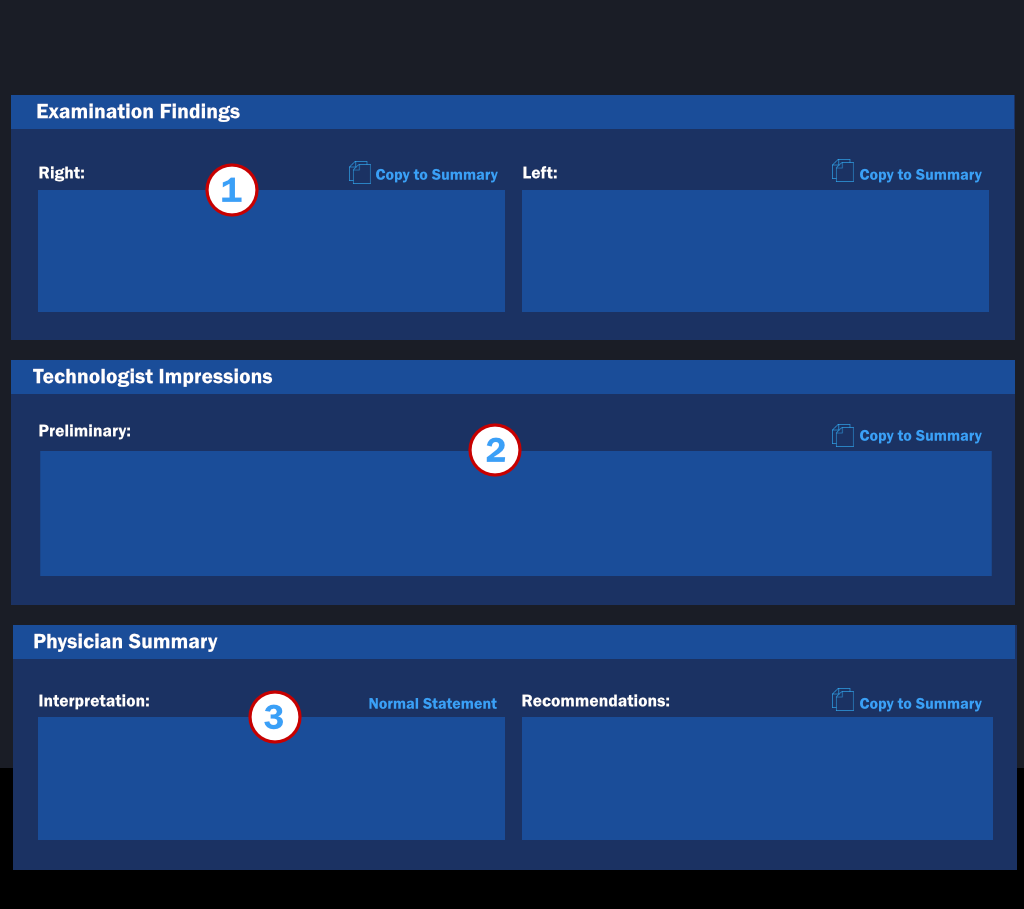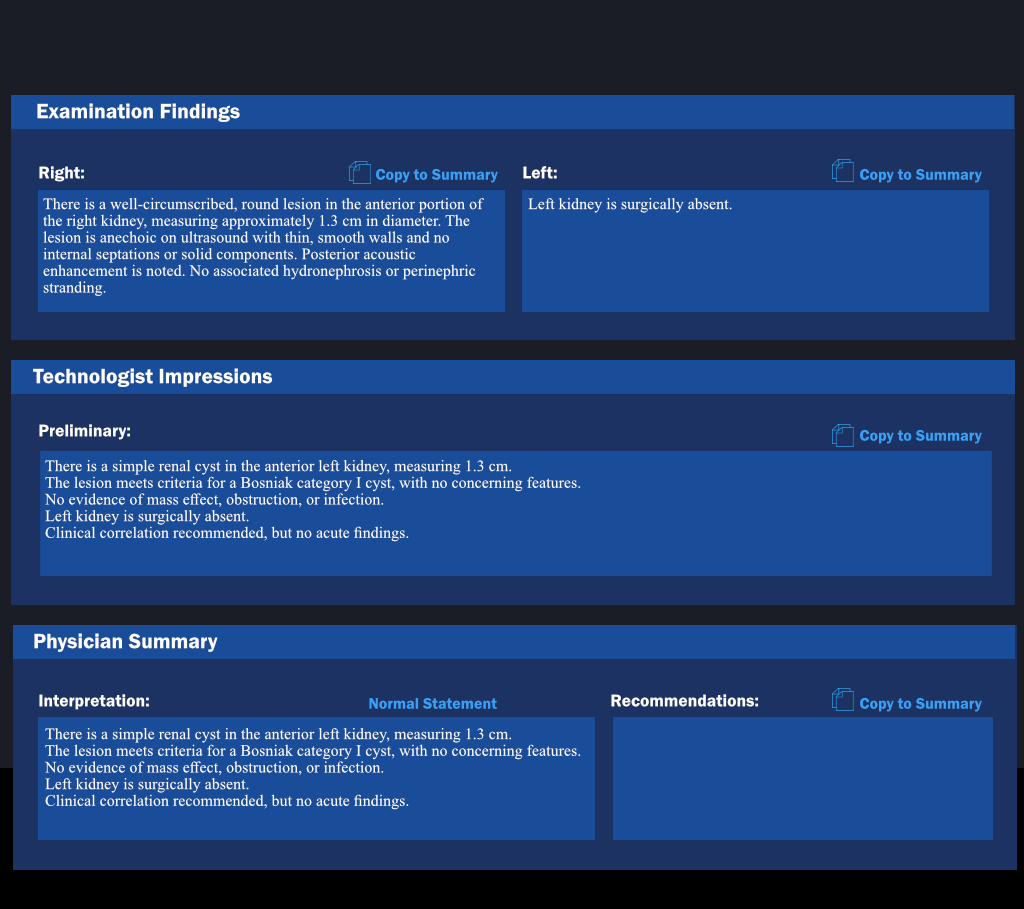Background
I am a medical imaging technologist working in the Tacoma, WA area. I am considering coming forward as an anonymous whistleblower regarding several laws I believe are being violated at my workplace, specifically concerning the processes involved in the documentation and final interpretation of imaging exams.
Potential Legal Violations
The first potential legal violation is both straightforward and readily provable. Imaging technologists have been instructed by management to write the final interpretations on behalf of the reading physicians, without any input from those physicians at any point in the process. I have been informed by multiple sources that it is unlawful for imaging technologists to interpret the findings of an imaging exam and that doing so would constitute a violation of the False Claims Act (FCA). I have not verified this with any state or federal governments.
The two images below are recreations of our report-writing software interface. They display sections labeled Examination Findings, Technologist Impressions, and Physician Summary. The Examination Findings and Technologist Impressions are written by the technologist. It is within the technologist's legal scope to complete the Examination Findings, which describe what is visually observed in the exam images—without interpretation of disease processes or abnormalities. The Technologist Impressions section, however, is problematic. This section does not appear to be part of the software’s default layout but was reportedly added by management at our imaging lab. In this section, the technologist enters the the physician's interpretation. The final section, Physician Summary, is where the reading physician is supposed to document their final interpretation of the exam. However, because the imaging technologists are writing the interpretations, the physicians use a shortcut. By clicking a link labeled "Copy to Summary" in the Technologist Impressions section, the physician can automatically transfer the technologist’s text into the Physician Summary field. The second image below demonstrates this process using sample data: it shows that the text in the Technologist Impressions and Physician Summary fields is identical, indicating that the physician's interpretation was simply copied from what the technologist had written.

Areas 1 and 2 of the report are by written the technologist.

An example of how a finalized report appears in the report writing software. Note the "Technologist Impressions" written by the technologist can still be viewed. The "Technologists Impressions" and "Physicians Interpretation" are exact copies.
When I was hired for my position as an imaging technologist at my current employer in 2012, I was told that the reading physicians would review what the technologist had written for the interpretation and then make any corrections they deemed necessary. Given the mistakes I have found carried over from the technologist’s interpretation to the physician’s interpretation, I doubt this is always occurring.
The second potential legal violation stems from the first. As technologists, we can observe the studies being read almost in real time. Each study has an icon that changes when the report status updates from 'unread' to 'finalized.' Based on how quickly some reading physicians complete their reports, I believe they are not always reviewing the exam images. Since the interpretation has already been written by the technologists, the physicians do not need to view the images themselves. I’ve been informed the reporting software we use (Epic Systems Corporation - Verona Wisconson) is capable of tracking whether the images were viewed—and for how long—but I am unable to confirm this.
To illustrate how quickly some imaging exams can be interpreted and finalized, I recently reviewed the timestamps of three exams that appeared to be read rapidly. Together, these three exams contained a total of 132 images. The first exam was finalized at 5:05 p.m., the second at 5:06 p.m., and the third—also at 5:06 p.m. Notably, the final two exams were completed within the same minute, according to the report-generation software.
In addition, I have observed errors made by technologists in writing the physician’s interpretation that are carried over uncorrected from the Technologist Impressions section to the Physician Summary. On two occasions, I have seen studies finalized by the reading physician that contained no attached images. I have also seen the same interpretation text duplicated in the final report, suggesting that the reading physician clicked the “Copy to Summary” link in the Technologist Impressions section more than once and did not notice the text was duplicated in the Physicians Interpretation.
Finally, as I have been regularly preparing reports on behalf of the reading physicians, I have effectively been performing duties outside of my scope of practice and without compensation. Given this, I believe it would be reasonable for my employer to reimburse me for a portion of the reading fees paid to the physicians. I have been employed with the same organization since 2012 and have written approximately 9,600 exam reports during that time.
Career Ending Decision
If I decide to proceed as an anonymous whistleblower, it is unlikely I will find work again in medical imaging. The field in which I work has a relatively small workforce compared to most other areas in healthcare, making it easier for others to uncover a person's background. Imaging managers understand that a technologist who reports legal violations would be committing career suicide, which significantly discourages reporting. I am also an older tech and finding work in this particular imaging field for anyone my age is almost impossible.
My impetus for coming forward stems from years of harassment and intimidation in my workplace. To those familiar with the harassment I have endured, it would be obvious that I was the whistleblower. I would only consider coming forward if the government can assure me that I would receive a whistleblower reward sufficient to cover at least ten years of wages and health insurance coverage.
In 2024 alone, more than 24,000 imaging exams were performed at my workplace and affiliated satellite offices in the local area, with physician interpretations written by technologists in nearly all—if not all—cases. Since the technologists can confirm they are the ones writing these interpretations, and their input is visible in the report-writing software on finalized reports, it should be a straightforward process to demonstrate that illegal activity is occurring (if, in fact, this practice is unlawful). If we assume the penalty for each instance of a technologist writing the final interpretation on behalf of a reading physician is $10,000, and there were over 24,000 imaging studies performed last year alone, the government could make the resulting fines substantial enough to cover a whistleblowers wages for a ten year period.